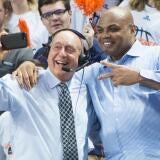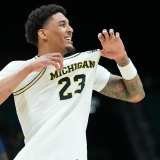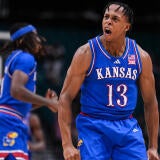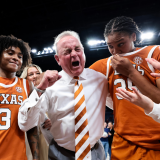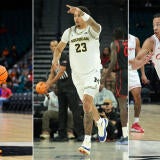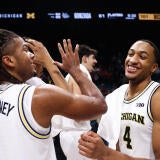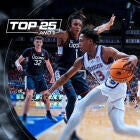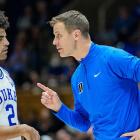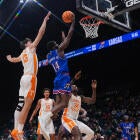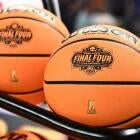College basketball is losing more underclassmen every year to the NBA Draft, but can the NCAA reverse the trend?
The sport's on track to have less talent than ever before but paying players could help solve the problem
College basketball has a defection issue that, with each passing year, is growing more obvious and troublesome.
The sport isn't explicitly approaching a crisis, but if the NCAA doesn't seek a way to keep its underclassmen with fringe NBA talent from leaving college for good, a sport set back by a lack of star power will become all the more humdrum -- and thus less nationally relevant -- than it already struggles with.
Because no more Zions are coming down the pike.
When top-five prospect RJ Hampton announced Tuesday he would be dodging college in favor of playing professionally in New Zealand for a year, it caused predictable hand-wringing about what his decision meant for college basketball. In reality, Hampton's choice was much more an indictment of the G League, which in 2018 introduced six-figure salaries to, in part, entice high schoolers who sought to ignore college in favor of a professional track to the NBA. Hampton bypassing the G League was more damaging, and arguably more embarrassing, for that organization than it was for college hoops.
Really, college basketball's true immediate-and-long-term problem came into view Thursday morning when the list of players who opted to stay in the 2019 NBA Draft pool crystallized. A generous forecast of this year's draft allots 45 of the 60 picks to go to underclassmen from American universities. Yet nearly double that amount are keeping their names in and will never play for a school again.
These aren't all misguided souls. They have the right to make the decisions they feel are best for them for whatever reasons (money atop the list for most, surely) drive them to do so. They're players who have spent a year or two or even three in college and are just done with it. The unforgiving world can get aggressively real once you leave college behind for good, and a big batch of these men are about to discover that exciting but harsh reality. Many are going to look up six months from now and find themselves a universe away from the glamour of high-level D-I ball, caught in the schlep, staying in average hotels and playing in front of less than a thousand people in G League games almost nobody will care about.
Would this be the case if the NCAA enacted Name, Image and Likeness (NIL) rules that allowed college players to make money off their own NIL? Probably not. If you told a college sophomore with almost no chance of being drafted that he could chase a two-way NBA deal, or return to college and potentially make $20,000 off his NIL because he was the BMOC, don't you think the latter option would entice just a few more players to head back to school? The players should already be afforded the opportunity to get this money anyway. Now that college basketball's collective crop of talent is becoming thinner by the year, maybe the NCAA will finally find a way to allow it to happen.
It might be why the NCAA has formally started the process of, at the very least, discussing the NIL issue and how it could be adopted for college athletes.
It used to be that a college team didn't need to worry about losing its second- or third-best players if those players projected beyond the top 30 or 40 in a given year's mock-draft consensus. That era is now gone. At this point, if a player is for sure considered a top-100 draft prospect (forget a first-round guy or even top 60), coaches should expect to lose said player to the allure of chasing the NBA dream, even if that dream is not immediately within grasp.
You don't need to be drafted in order to make it in the pros. That has long been a selling point of the NFL, and it's looking more viable by the year with the NBA. Every player agent of every prospect not projected to be selected in this year's draft can point to Fred VanVleet, undrafted out of Wichita State in 2016 and playing a pivotal role for the Toronto Raptors in the 2019 NBA Finals, as one example among plenty the NBA now has to offer.
The mass-exodus trend is growing to levels never before conceived. Over the past four draft cycles, this year included, the number of players who have declared early and subsequently kept their names in has risen with a quickness -- and bear in mind that these numbers have steadily grown from the previous decade, which were larger than the numbers of early entrants for the 40 years before that.
This is college basketball's new normal: In 2016, 117 underclassmen declared. In 2017, the number bumped to 137. Last year saw a jolt: 181 college players put their names into the draft. This year was a slight dip back to 175, but the number of players who remained in the pool grew ever larger in 2019, continuing a trend that shows no signs of reversing, not with agents now allowed at the table.
Here are the number of underclassmen who remained in the pool before the draft:
- 2016: 59
- 2017: 64
- 2018: 79
- 2019: 86
With just 60 draft spots, this seems like collective faulty logic on behalf of supposed misguided college underclassmen. There will almost certainly be more freshmen, sophomores and juniors who go unselected in 2019 than any year before it. In 2020, it's plausible the number gets even larger.
But purely getting drafted is not the goal for the prospects who know they're on the margins. The reasons for the boom are plenty, but the most unmissable are that making money has never been easier right out of the gate, that second-round picks are getting guaranteed deals at levels never before seen, and that two-way contracts have never been this enticing. But the number of roster spots aren't expanding to correlate with the number of players leaving school. Remember: a lot of really good seniors are going to get those roster spots too, be it in the G League or with premier teams overseas.
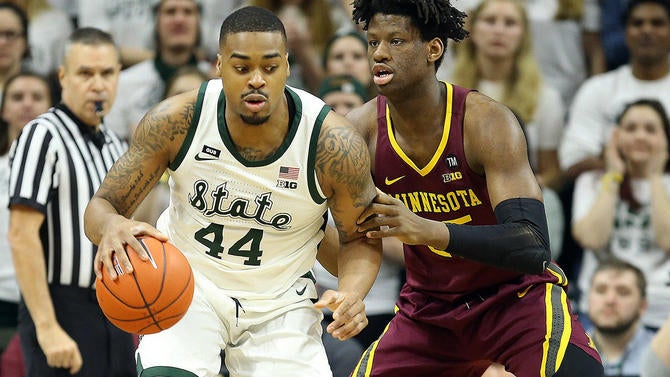
And things are tracking to get a lot thornier. By 2022, if Adam Silver and the NBA can convince the National Basketball Players Association to revert the age minimum to 18 years old, the talent drain on college hoops will be at an all-time high. The sport will miss out on anywhere from the top 10-25 prospects coming out of high school in addition to the herd of underclassmen who don't come back.
All told, you could have college basketball deprived of 100 or more players who would be eligible to play in college but nonetheless circumvent the NCAA and its relatively restrictive rules on amateurism. That's the larger issue. It's on the sport's ambassadors and power brokers, now, to make moves to lessen the damage and improve inauspicious attrition rates.
A snapshot of how college basketball is becoming alienated by professional opportunities: If Kerry Blackshear, who opted to return to college but will leave Virginia Tech, transfers outside of the ACC, the league will not return an all-ACC player from its first or second teams for the first time in its history. This is how college basketball gets sanded down. It was one thing to not have most All-Americans returning in recent years, but when big-time conferences aren't bringing back any of their 10 best players, it's an issue demanding attention. Turnover is the nature of college basketball, but this is worming to wide-scale talent-siphoning -- which is to say nothing of the 800-plus players who transfer from one spot to another.
It wasn't so long ago that guys like Doug McDermott, Kris Dunn and Willie Cauley-Stein opted to return to school even when they would have been top-20 picks. Now that's almost impossible to imagine. Things have shifted drastically in only a few years' time, and the fact that players can now engage in formal relationships with agents upon declaring for the draft has been the ultimate crossing of the Rubicon in this respect.
Take a look at the underclassmen who returned this year, the ones considered even half-surprises: Tre Jones at Duke, Ashton Hagans at Kentucky, Devon Dotson at Kansas, Ayo Dosunmu at Illinois and Jordan Nwora at Louisville. The list is smaller than ever.
Contrast that with names of only some of the guys who are gone from college forever: Jordan Bone, Ky Bowman, Iggy Brazdeikis, Armoni Brooks, Amir Coffey, Tyler Cook, Kyle Guy, Jaylen Hands, Jared Harper, VJ King, Martin Krampelj, Cameron Lard, Dedric Lawson, Zach Norvell, Jaylen Nowell, Shamorie Ponds, Jordan Poole, Brandon Randolph, Simi Shittu, Justin Simon, Nick Ward, Kenny Wooten.
All those players qualified as top-three guys, at worst, on their teams. None are projected as obvious top-40 picks -- and all but maybe three or four will go undrafted. You can't tell me college basketball is better off for not having them next season. If you could even entice one-fourth of the names on that list to return, the sport would be a preferable product.
Coaches always have been and always will be the true stars of college hoops, but if the sport is going to find firmer tread in marketing its players, in the hopes of holding onto them, it needs to find a way to reward them monetarily as soon as possible. The realities of how much money players could bring in while profiting off their NIL is another matter, but it's a matter they at the very least deserve to encounter as soon as possible.
We can acknowledge two things happening at once here: happiness for the players to have the freedom and empowerment to make these choices en masse, but concern for college basketball's well-being to lose upper-end talent in gobs like this to the point where it's impacting overall marketing, and potential success, for top 50-type schools.
College basketball is not dying nor is it in ominous peril, but it's also not trending in the right direction. Real legislation to alter its course needs to be made soon so, by 2022, we don't come to see many of the best would-be college players playing basketball everywhere except ... in college.


